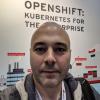It's been just over three years since Solomon Hykes presented the world with the (so far) most creative way to use the tar command: the Docker project. Not only does the project combine existing container-technologies and make them easier to use, but its well-timed introduction drove an unprecedented rate of adoption for new technology.
Did people run containers before the Docker project? Yes, but it was harder to do so. The broader community was favoring LXC, and Red Hat was working on a libvirt-based model for Red Hat Enterprise Linux. With OpenShift 2, Red Hat had already been running containers in production for several years - both in an online PaaS as well as on-premise for enterprise customers. The model pre-Docker however was fundamentally different from what we are seeing today: rather than enabling completely independent runtimes inside the containers, the approach in
OpenShift 2 and libvirt-lxc was to partition the host, re-using the software installed on the host-machine. There were several issues with this model, however, with the most prominent being complexity. Modern deployments are so complex that the process of recreating an application stack (from a puppet manifest, for example) over and over again in dev / test / ops has become too fragile.
This mirrors the problem that we faced with the predominant operational model roughly 20 years ago, when we moved from compiling software on local machines to pre-build binary distribution with rpm. The issue we solved in the “olden days” was that the behavior of a locally compiled application was dependent on the state of the machine at build time and the overhead of this model. We needed binary distribution to achieve a predictable experience of the aggregate software stack.
Today, stacks are so complex and changes in software streams so frequent, that the stack you build is neither what you test nor is what you end up running in production; adding on top of this is the demand for updating applications/systems in place. This brings us back to a situation where the behavior of a production software stack simply becomes dependent on too many variables.
So how do containers, specifically the packaging as provided by the Docker project, marginalize if not outright eliminate these variables? By partitioning and aggregating, of course, which leads to a whole other set of challenges and solutions...but that’s for my next post.
Über den Autor
Daniel Riek is responsible for driving the technology strategy and facilitating the adoption of Analytics, Machine Learning, and Artificial Intelligence across Red Hat. Focus areas are OpenShift / Kubernetes as a platform for AI, application of AI development and quality process, AI enhanced Operations, enablement for Intelligent Apps.
Nach Thema durchsuchen
Automatisierung
Das Neueste zum Thema IT-Automatisierung für Technologien, Teams und Umgebungen
Künstliche Intelligenz
Erfahren Sie das Neueste von den Plattformen, die es Kunden ermöglichen, KI-Workloads beliebig auszuführen
Open Hybrid Cloud
Erfahren Sie, wie wir eine flexiblere Zukunft mit Hybrid Clouds schaffen.
Sicherheit
Erfahren Sie, wie wir Risiken in verschiedenen Umgebungen und Technologien reduzieren
Edge Computing
Erfahren Sie das Neueste von den Plattformen, die die Operations am Edge vereinfachen
Infrastruktur
Erfahren Sie das Neueste von der weltweit führenden Linux-Plattform für Unternehmen
Anwendungen
Entdecken Sie unsere Lösungen für komplexe Herausforderungen bei Anwendungen
Original Shows
Interessantes von den Experten, die die Technologien in Unternehmen mitgestalten
Produkte
- Red Hat Enterprise Linux
- Red Hat OpenShift
- Red Hat Ansible Automation Platform
- Cloud-Services
- Alle Produkte anzeigen
Tools
- Training & Zertifizierung
- Eigenes Konto
- Kundensupport
- Für Entwickler
- Partner finden
- Red Hat Ecosystem Catalog
- Mehrwert von Red Hat berechnen
- Dokumentation
Testen, kaufen und verkaufen
Kommunizieren
Über Red Hat
Als weltweit größter Anbieter von Open-Source-Software-Lösungen für Unternehmen stellen wir Linux-, Cloud-, Container- und Kubernetes-Technologien bereit. Wir bieten robuste Lösungen, die es Unternehmen erleichtern, plattform- und umgebungsübergreifend zu arbeiten – vom Rechenzentrum bis zum Netzwerkrand.
Wählen Sie eine Sprache
Red Hat legal and privacy links
- Über Red Hat
- Jobs bei Red Hat
- Veranstaltungen
- Standorte
- Red Hat kontaktieren
- Red Hat Blog
- Diversität, Gleichberechtigung und Inklusion
- Cool Stuff Store
- Red Hat Summit

